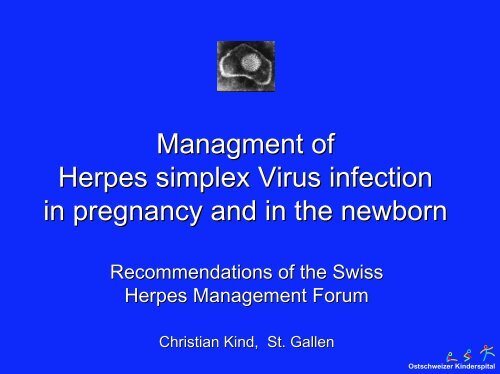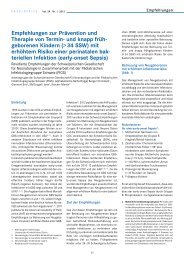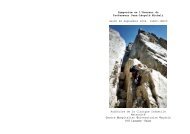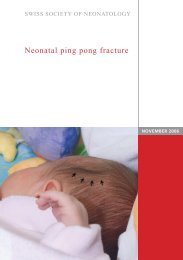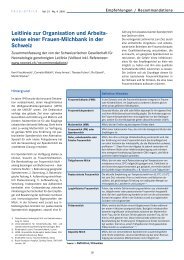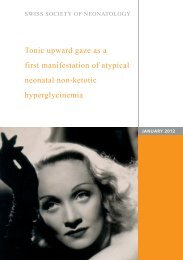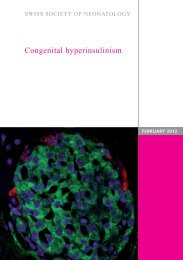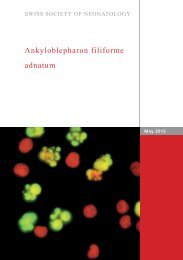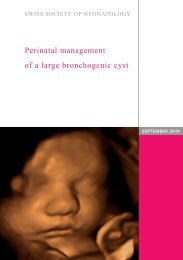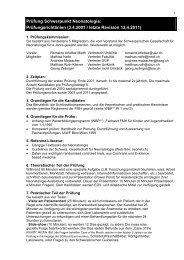Managment of Herpes simplex Virus infection in pregnancy and in ...
Managment of Herpes simplex Virus infection in pregnancy and in ...
Managment of Herpes simplex Virus infection in pregnancy and in ...
Create successful ePaper yourself
Turn your PDF publications into a flip-book with our unique Google optimized e-Paper software.
<strong>Managment</strong> <strong>of</strong><br />
<strong>Herpes</strong> <strong>simplex</strong> <strong>Virus</strong> <strong><strong>in</strong>fection</strong><br />
<strong>in</strong> <strong>pregnancy</strong> <strong>and</strong> <strong>in</strong> the newborn<br />
Recommendations <strong>of</strong> the Swiss<br />
<strong>Herpes</strong> Management Forum<br />
Christian K<strong>in</strong>d, St. St.<br />
Gallen<br />
Ostschweizer K<strong>in</strong>derspital
Situation <strong>in</strong> the delivery room<br />
• Baby girl, 37 0/7 W GA, BW 2720g<br />
• Mother 35-y. gravida 1, para 1<br />
• Delivery by elective cesarean section after development <strong>of</strong><br />
active genital herpes the day before<br />
• Mother had been treated for genital herpes type 2 twice<br />
dur<strong>in</strong>g the preced<strong>in</strong>g years<br />
• Spontaneous adaptation, adaptation Apgar 5 / 7 / 8<br />
• At age 1 hour moderate respiratory distress requir<strong>in</strong>g<br />
fi O 2 <strong>of</strong> 30%<br />
• No cutaneous lesions visible<br />
Ostschweizer K<strong>in</strong>derspital
How do you proceed? proceed<br />
• Start iv acyclovir immediately <strong>and</strong> transfer to<br />
neonatology unit<br />
• Culture swabs <strong>of</strong> oropharynx und conjunctiva for<br />
<strong>Herpes</strong> <strong>simplex</strong><br />
Proceed accord<strong>in</strong>g to culture results<br />
• Base management exclusively on further cl<strong>in</strong>ical<br />
course<br />
Ostschweizer K<strong>in</strong>derspital
Risk <strong>of</strong> per<strong>in</strong>atal HSV transmission<br />
Seattle: 202 parturients with positive cultures, cultures,<br />
10 neonatal<br />
<strong><strong>in</strong>fection</strong>s<br />
% <strong>in</strong>fected OR (95% CI)<br />
• Infection episode<br />
– Reactivation (antibody ( antibody +) 1.3%<br />
– First episode (no ( no antibody) antibody 30.8% 33.1 (6.5-168)<br />
• HSV type<br />
– HSV-2 2.7%<br />
– HSV-1 31.3% 16.5 (4.1-65)<br />
• Mode <strong>of</strong> delivery<br />
– Vag<strong>in</strong>al 7.7%<br />
– Cesarean section 1.2% 0.14 (0.02-1.08)<br />
Brown ZR et al JAMA 2003; 289:203-9<br />
Ostschweizer K<strong>in</strong>derspital
Per<strong>in</strong>atal risk with<br />
reactivation <strong>of</strong> HSV-2<br />
• Parturients with positive culture at delivery 140<br />
– Cl<strong>in</strong>ical lesions present 50<br />
• Cesarean section 38<br />
• Vag<strong>in</strong>al delivery 12<br />
– Cl<strong>in</strong>ical lesions absent 90<br />
• Cesarean section 18<br />
• Vag<strong>in</strong>al delivery 72<br />
• Neonatal <strong><strong>in</strong>fection</strong> 0<br />
Brown ZR et al JAMA 2003; 289:203-9<br />
Ostschweizer K<strong>in</strong>derspital
% NG mit ANS<br />
8<br />
7<br />
6<br />
5<br />
4<br />
3<br />
2<br />
1<br />
0<br />
Why has the baby<br />
respiratory distress? distress<br />
Frequency <strong>of</strong> RDS <strong>in</strong> 33 289 term <strong>in</strong>fants <strong>in</strong> Cambridge<br />
37 0/7 - 6/7 38 0/7 - 6/7 39 0/7 - 6/7<br />
Gestationsalter SSW<br />
Morrison JJ et al Br J Obstet Gynaecol 1995; 102:101-6<br />
Elektive Sectio<br />
Sekundäre Sectio<br />
Vag<strong>in</strong>ale Geburt<br />
Ostschweizer K<strong>in</strong>derspital
Neonatal<br />
<strong>Herpes</strong> <strong>simplex</strong> <strong><strong>in</strong>fection</strong><br />
• Three cl<strong>in</strong>ical presentations:<br />
presentations<br />
– Localised (Sk<strong>in</strong>, eyes, eyes mouth) mouth<br />
50%<br />
– CNS – Dissem<strong>in</strong>iated<br />
33%<br />
(Hepatitis, DIC, shock, shock pneumonitis) pneumonitis 17%<br />
• Start <strong>of</strong> symptoms: symptoms<br />
– 1. Day <strong>of</strong> life 9%<br />
– Day 2-5 30%<br />
– After 5 days 60%<br />
Kimberl<strong>in</strong> DW Pediatrics 2001; 108:223-9<br />
Ostschweizer K<strong>in</strong>derspital
Symptoms at presentation<br />
• Sk<strong>in</strong> vesicles 68%<br />
• Fever 39%<br />
• Lethargy 38%<br />
• Seizures 27%<br />
• Conjunktivitis 19%<br />
• Pneumonitis 13%<br />
• DIC 11%<br />
Kimberl<strong>in</strong> DW Pediatrics 2001; 108:223-9<br />
Ostschweizer K<strong>in</strong>derspital
Progonosis after<br />
high dose acyclovir<br />
• Dissem<strong>in</strong>ated <strong><strong>in</strong>fection</strong>: <strong><strong>in</strong>fection</strong><br />
– Death 31%<br />
– Sequelae <strong>in</strong> survivors 17%<br />
• Infection <strong>of</strong> CNS:<br />
– Death 6%<br />
– Sequelae <strong>in</strong> survivors 69%<br />
• Severe 39%<br />
• Moderate 15%<br />
• Mild 15%<br />
• Average duration <strong>of</strong> symptoms at start <strong>of</strong> tx 5.6-7.4 days! days<br />
Kimberl<strong>in</strong> DW Pediatrics 2001; 108:223-9<br />
Ostschweizer K<strong>in</strong>derspital
Detection <strong>of</strong> newborns at risk? risk<br />
• Culture at birth pos 10 202<br />
neg 6 39821<br />
• History for genital herpes pos 4 102<br />
(with with pos. pos culture) culture<br />
neg 6 100<br />
• Cl<strong>in</strong>ical lesions at delivery ja 0 74<br />
(with ( with pos. pos culture) culture)<br />
ne<strong>in</strong> 10 128<br />
• Serology neg 6 11115<br />
pos HSV-1 6 23480<br />
pos HSV-2 2 5761<br />
pos both 1 8034<br />
Brown ZR et al JAMA 2003; 289:203-9<br />
newborn <strong>in</strong>fected exposed<br />
Ostschweizer K<strong>in</strong>derspital
Ostschweizer K<strong>in</strong>derspital
Members <strong>of</strong> the Swiss <strong>Herpes</strong><br />
Management Forum<br />
• Dermatology: S. Büchner, Basel, W. Kempf, Zürich,<br />
S. Lautenschlager, Zürich<br />
• Internal medic<strong>in</strong>e:H. H. Hirsch, Basel, P. P. Reusser,<br />
Porrentruy<br />
• Microbiology: P. Meylan, Lausanne, W. Wunderli, Genève<br />
• Neonatology: C. K<strong>in</strong>d<br />
• Obstetrics: S. Gerber, Lausanne, U. Lauper, Zürich<br />
• Ophthalmology: J. Garweg, Bern<br />
• Pediatrics: D. Nadal, Zürich<br />
• Sponsor: GlaxoSmith Kl<strong>in</strong>e, Münchenbuchsee<br />
Ostschweizer K<strong>in</strong>derspital
Guidel<strong>in</strong>es endorsed by<br />
• Swiss Society for Dermatology <strong>and</strong> Venerology<br />
• Swiss Society for Urology<br />
• Swiss Society for Allergology <strong>and</strong> Immunology<br />
• Swiss Society for Gynaecology <strong>and</strong> Obstetrics<br />
• Swiss Society <strong>of</strong> Ophthalmology<br />
• Swiss Society <strong>of</strong> Paediatrics<br />
• Swiss Society <strong>of</strong> Neonatology<br />
• Swiss Society for Infectious diseases<br />
• Swiss Society <strong>of</strong> Haematology<br />
• Swiss Society for Oncology<br />
• Swiss Society <strong>of</strong> Internal Medic<strong>in</strong>e<br />
• Swiss Society <strong>of</strong> General Practice Medic<strong>in</strong>e<br />
• Swiss Society for Microbiology<br />
Ostschweizer K<strong>in</strong>derspital
Recommendations for <strong>pregnancy</strong><br />
• No serological or virological screen<strong>in</strong>g<br />
• Treat cl<strong>in</strong>ical episodes with acyclovir<br />
• Use suppressive treatment from 36 weeks <strong>of</strong> <strong>pregnancy</strong> <strong>in</strong><br />
case <strong>of</strong> high risk <strong>of</strong> recurrence<br />
• Deliver by cesarean section if active cl<strong>in</strong>ical lesions or<br />
prodromal pa<strong>in</strong> at time <strong>of</strong> presentation for labor<br />
• Do not perform c-sectionc- section for<br />
– History <strong>of</strong> genital herpes <strong>in</strong> absence <strong>of</strong> lesions<br />
– Cl<strong>in</strong>ical lesions <strong>in</strong> the absence <strong>of</strong> labor or rupture <strong>of</strong><br />
membranes before 39 weeks<br />
Ostschweizer K<strong>in</strong>derspital
Rupture <strong>of</strong> membranes <strong>in</strong> the<br />
presence <strong>of</strong> herpes lesions<br />
• If pulmonary maturity is probable<br />
– perform cesarean section as soon as possible (no ( no later<br />
than 4-6 hours) hours<br />
• If lungs immature<br />
– low risk with expectant management <strong>in</strong> the case <strong>of</strong><br />
recurrent maternal herpes (Major CA et al, al,<br />
Am J<br />
Obstet Gynecol 2003; 188:1551-1555)<br />
– very difficult situation <strong>in</strong> the case <strong>of</strong> known maternal<br />
primary <strong><strong>in</strong>fection</strong><br />
Ostschweizer K<strong>in</strong>derspital
Management <strong>of</strong> the<br />
exposed neonate<br />
• If cl<strong>in</strong>ically active lesions or positive cultures at birth<br />
→<br />
culture swabs from conjunctiva, conjunctiva oropharynx <strong>and</strong> rectum<br />
between 24 <strong>and</strong> 48 hours <strong>of</strong> life<br />
• Observe for cl<strong>in</strong>ical symptoms, symptoms,<br />
also after discharge (4-6<br />
weeks) weeks)<br />
→ <strong>in</strong>struction <strong>of</strong> parents<br />
• Antiviral therapy only for symptomatic <strong>in</strong>fants or with<br />
positive cultures<br />
Ostschweizer K<strong>in</strong>derspital
Th<strong>in</strong>k herpes! herpes<br />
• The majority <strong>of</strong> neonatal herpes <strong><strong>in</strong>fection</strong>s occur after no<br />
known exposure<br />
• 1/3 <strong>of</strong> <strong>in</strong>fected <strong>in</strong>fants have no vesicles<br />
• Consider herpes <strong><strong>in</strong>fection</strong> <strong>in</strong> any case <strong>of</strong><br />
– Cutaneous, Cutaneous mucosal <strong>and</strong> conjunctival lesions<br />
– Seizures; Seizures lethargy<br />
– Fever or other systemic symptoms<br />
Without any other explanation<br />
Ostschweizer K<strong>in</strong>derspital
Management <strong>of</strong> suspected<br />
neonatal herpes <strong><strong>in</strong>fection</strong><br />
• Culture swabs from vesicles, vesicles conjunctiva, conjunctiva oropharynx<br />
ev. ev stools/rectal stools rectal swab, swab ur<strong>in</strong>e, ur<strong>in</strong>e blood<br />
• LP for PCR<br />
• Chemistry <strong>in</strong>cl. <strong>in</strong>cl transam<strong>in</strong>ases <strong>and</strong> coagulation studies<br />
• Acyclovir iv 60 mg/kg/d <strong>in</strong> 3 x<br />
• For 2 weeks <strong>in</strong> localised <strong><strong>in</strong>fection</strong><br />
• For 3 weeks <strong>in</strong> CNS or dissem<strong>in</strong>ated <strong><strong>in</strong>fection</strong><br />
(ev ev. Repeat LP for PCR after discont<strong>in</strong>uation)<br />
discont<strong>in</strong>uation<br />
• Cutaneous recurrences possible für months<br />
(ev ev. suppression with acyclovir po) po<br />
Kimberl<strong>in</strong> DW Pediatrics 2001; 108:230-8<br />
Ostschweizer K<strong>in</strong>derspital
Preventive measures<br />
• Isolate newborn with neonatal herpes <strong>and</strong> avoid direct<br />
contact with lesions <strong>and</strong> body fluids<br />
• Protect healthy newborns from direct contact with herpes<br />
lesions <strong>in</strong> adults (on ( on lips, lips f<strong>in</strong>gers, f<strong>in</strong>gers nipples) nipples by sealed<br />
cover<strong>in</strong>g <strong>of</strong> lesions<br />
• Medical staff with oral herpes need not be suspended<br />
from car<strong>in</strong>g for neonates<br />
Ostschweizer K<strong>in</strong>derspital


